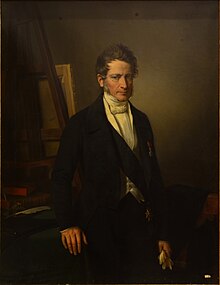Fleury François Richard
Fleury François Richard | |
|---|---|
 Fleury–Richard (self portrait in youth) | |
| Born | Fleury François Richard 25 February 1777 |
| Died | 14 March 1852 (aged 75) |
| Known for | Painting |
| Movement | Romanticism, Troubadour style |

Fleury François Richard (25 February 1777, Lyon – 14 March 1852, Écully), sometimes called Fleury-Richard, was a French painter of the Lyon School. A student of Jacques-Louis David, Fleury-Richard and his friend Pierre Révoil were precursors of the Troubadour style.
Life
The son of a magistrate, Fleury François Richard studied at the collège de l'Oratoire in
In 1808 he set up his own studio at the
Seeking inspiration, he visited Geneva, Milan, Turin and the Dauphiné. He served as a professor at the École des beaux-arts de Lyon from 1818 to 1823. In 1851 he set himself up at Écully, devoting himself to writing. He edited his Souvenirs, lives of painters and a work on painting in the second-order towns of France, Quelques réflexions sur l'enseignement de la peinture dans les villes de second ordre.
Critique
Fleury-Richard received his first lessons in Lyon, a silk-producing town, but he was mainly formed by his time in the
On his return to Lyon, he cultivated his friendship with
When some scholars at the start of the 20th century sought to connect him to the
In Fleury-Richard's critical writings scholars find a reflection prefiguring his attachment to Symbolism before it existed: "Painting is not an imitation of reality. It is a symbol, a figurative language which presents the image of thought; and thought rises to the source of infinite beauty, there finding the archetypical forms signalled by Plato, of which created beings are only copies.[4]"
Works
- Saint-Petersburg
- Charles VII writing his farewell to Agnès Sorel (1804) musée national des châteaux de Malmaison et de Bois-Préau, Rueil-Malmaison
- musée des beaux-arts de Lyon
- The death of saint Paul the hermit (1810) musée Gassendi Digne
- Tannegui du Chastel saving the Dauphin (1819) musée national du château de Fontainebleau
- The Hermitage of Vaucouleurs (1819), musée du Louvre, Paris
- Little Red Riding Hood (c. 1820), musée du Louvre, Paris
- Montaigne Visiting Torquato Tasso in Prison (1821), Lyon
- Vert-Vert (1821) Lyon
- The death of the prince de Talmont (c. 1822), musée de Brou, Bourg-en-Bresse
- The Charterhouse of St Bruno (1822) musée de Grenoble
- Young Woman at a Fountain (1824), Lyon
- Comminges and Adelaide in the Trappist Monastery (1844), Lyon
- Interior of a convent (Couvent des Cordeliers de l'Observance), Lyon
- Scene in a ruined chapel, Lyon
- Entrance to a convent, Lyon
- Jacques de Molay, grandmaster of the Templars, Rueil-Malmaison
- Madame Elisabeth in her garden of Montreuil, musée national du château et des Trianons, Versailles
Gallery
-
Interior of a convent (Couvent des Cordeliers de l'Observance), Lyon
-
Scene in a Ruined Chapel (1824), Lyon
Bibliography
- (in French) Fleury Richard et Pierre Révoil : la peinture troubadour, Marie-Claude Chaudonneret, Arthéna, Paris (1980) 217 pp. [1]
- (in French) Le Temps de la peinture, Lyon 1800–1914, sous la direction de Sylvie Ramond, Gérard Bruyère et Léna Widerkher, Fage éditions, Lyon (2007) 335 pp. ISBN 978-2-84975-101-5
Notes
- ^ "To the exasperation of public thematic works and heroic virtue, of which Davidian painting was the highest expression, they had been succeeded – at least among the inhabitants of Lyon – by the cult of sentiment, the desire to approach the private life of historical people" – (in French) François-René Martin, Historicisme et utopie à Lyon au XIXe siècle, in Le Temps de la peinture, op. cit., p. 152.
- ^ (in French) François-René Martin, ibidem.
- ^ Alphonse Germain, cited by Pierre Vaisse, Le Temps de la peinture, op. cit. p. 21.
- ^ Quoted by Stephen Bann, Le Temps de la peinture, op. cit., p. 57.
Sources
- Le Temps de la peinture – Lyon 1800–1914, op. cit. pp. 305–306, 6 et ss.
- Base Joconde Archived 11 February 2011 at the Wayback Machine
- Musée des beaux-arts de Lyon
External links
- (in French) Notices on base Joconde



